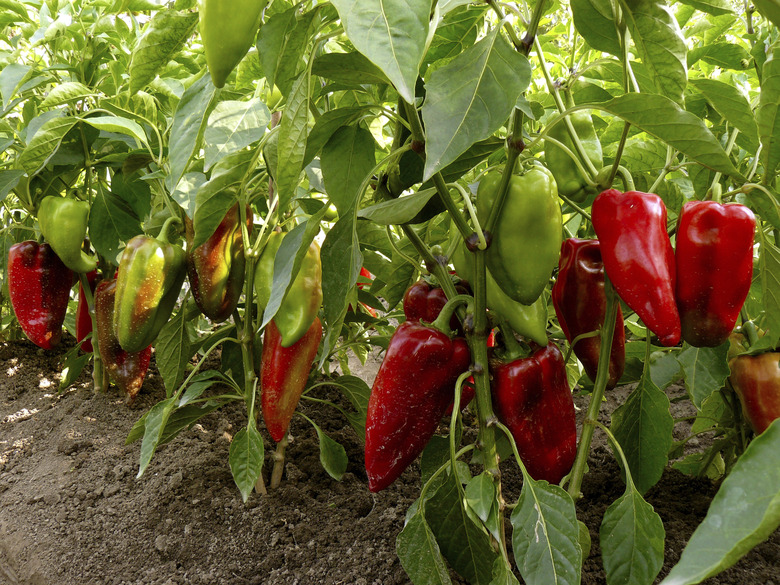Do Green Peppers Turn Red On The Vine?
Bell peppers (Capsicum annuum) brighten countless dishes, from comfort foods to summer salads, and figure in many ethnic recipes as well. There's little difference between green and red bell peppers — **red bells are just green bells that have ripened**.
Bell peppers (Capsicum annuum) brighten countless dishes, from comfort foods to summer salads, and figure in many ethnic recipes as well. There's little difference between green and red bell peppers — red bells are just green bells that have ripened. Patience, the right cultivar and a long enough growing season will turn a green pepper red on the vine.
Perfect Peppers
Grown in most gardens as annuals, bell peppers are hardy in U.S. Department of Agriculture plant hardiness zones 9 through 11 and native to North and South America. Like their spicier Capsicum relatives, they are **very frost-tender and should be planted outside up to two weeks after tomatoes (Lycopersicon esculentum)** in full sun. Plant peppers after soil temperatures reach 70 degrees Fahrenheit following the last frost.
Bell peppers require warm air temperatures. Their optimal growing temperature is 70 to 75 F but they tolerate daytime temperatures up to 94 degrees, at which point fruit production begins to slow. Green fruit ripens to red, taking several months, often **changing through other colors such as yellow, orange, ivory or purple as it ripens.**
- Bell peppers (Capsicum annuum) brighten countless dishes, from comfort foods to summer salads, and figure in many ethnic recipes as well.
- Like their spicier Capsicum relatives, they are **very frost-tender and should be planted outside up to two weeks after tomatoes (Lycopersicon esculentum)** in full sun.
There's the Rub
Once the pepper has bloomed and set fruit, it might take **60 to 90 days to ripen.** Fortunately, the plant continues to bloom and set fruit as long as days are temperate and nighttime temperatures stay above 60 degrees Fahrenheit. As long as it's warm, peppers continue to produce fruit that ripens at varying rates. If temperatures dip or drought sets in, three months can stretch to more — right into fall when nighttime temperatures drop. At that point, pick the peppers you have rather than lose them. The **percentage of red to green peppers produced in any year will depend on the cultivar and that year's particular weather patterns.**
- Once the pepper has bloomed and set fruit, it might take **60 to 90 days to ripen.
- As long as it's warm, peppers continue to produce fruit that ripens at varying rates.
- If temperatures dip or drought sets in, three months can stretch to more — right into fall when nighttime temperatures drop.
Pepper Varieties
Choose a variety that matches your tastes — and your growing season — most closely. "King Arthur" ripens from green to red in 68 days, but "Yankee" takes 80 days. "Redskin Patio" takes 80 days, but grows easily in containers that can be moved indoors if necessary. Although typical peppers mature from green to red, some hybrids mature differently. "Chablis" ripens from green to white, orange or red in 60 days. A hybrid, "Chocolate Beauty," matures not to red but to plum-brown in 85 days. And, as with other Solanaceae, rotate crops and **plant peppers in the same part of the garden only once every four years.**
- Choose a variety that matches your tastes — and your growing season — most closely.
- " A hybrid, "Chocolate Beauty," matures not to red but to plum-brown in 85 days.
Pick Them Whenever
Pick your peppers when you want them. Green peppers, of course, are more piquant than those of other colors. Any color pepper provides its best taste when its flesh is firm and the skin tight. When a pepper's **skin begins to wrinkle,** it's past its ripe prime. There are benefits to patience, though. Ripe red bell peppers provide almost 10 times the daily value of vitamin A as green bells, twice the DV of vitamin C and **twice the amount of beta carotene.**
- Pick your peppers when you want them.
- Ripe red bell peppers provide almost 10 times the daily value of vitamin A as green bells, twice the DV of vitamin C and **twice the amount of beta carotene.
- **
